#Ludic Culture
Explore tagged Tumblr posts
Text
A Journey Through 2023: Stories, Games, and Adventures
Can I be honest with you? Then again, you’re here for a reason my confidant. Certainly we can be truthful with one another. I mean that’s why we’re compelled to tell our stories. Whether fictionalized or not we’re displaying and sharing ourninternal struggles through whatever medium they require, The Bad News (full disclosure: this sucks. skip to “Good News” if you’re not in the mood) 2023 hit…
View On WordPress
#comparative literature#creative writing#Digital narratives#game design#game development#Game Mechanics#Game Narrative#Game Studies Research#gaming culture#gaming industry#graduate school#graduate studies#Interactive storytelling#literary analysis#Literature and Games#Ludic Elements#Ludology#Ludonarrative#MFA in Creative Writing#MFA Thesis#narrative design#Narrative Structures#Narrative Techniques#PhD in Game Studies#Poetic Language#Poetry#Poetry and Play#poetry collection#poetry writing#Storytelling in Games
3 notes
·
View notes
Text
Hard to pick a favorite quote:
You see, while hype is nice, it's only nice in small bursts for practitioners. We have a few key things that a grifter does not have, such as job stability, genuine friendships, and souls. What we do not have is the ability to trivially switch fields the moment the gold rush is over, due to the sad fact that we actually need to study things and build experience. Grifters, on the other hand, wield the omnitool that they self-aggrandizingly call 'politics'. That is to say, it turns out that the core competency of smiling and promising people things that you can't actually deliver is highly transferable.
The only thing you should be doing is improving your operations and culture, and that will give you the ability to use AI if it ever becomes relevant. Everyone is talking about Retrieval Augmented Generation, but most companies don't actually have any internal documentation worth retrieving. Fix. Your. Shit.
Yes, someone needs to figure out what the implications of quantum computing are for cryptography, but I guarantee you that it is not Synergy Greg, who does not have any skill that you can identify other than talking very fast and increasing headcount. Synergy Greg should be not be consulted on any important matters, ranging from machine learning operations to tying shoelaces quickly. The last time I spoke to one of the many avatars of Synergy Greg, he insisted that I should invest most of my money into a cryptocurrency called Monero, because "most of these coins are going to zero but the one is going to one". This is the face of corporate AI. Behold its ghastly visage and balk, for it has eyes bloodshot as a demon and is pretending to enjoy cigars.
61 notes
·
View notes
Text
i think when people talk about D&D and the problems they think it has they tend to talk about it in exclusively ludic terms, about the design and the kind of play the design might engender. other reasons a person might play D&D are externalized and treated as sources of inertia. "no one would play D&D if it wasn't for..." all the reasons people do play it. but there are—besides commercial—cultural, aesthetic, and social factors that make D&D the game people want to play. so i think this kind of discussion assumes the initial point a little bit.
71 notes
·
View notes
Text
Abbott Elementary - Melissa dating a foreigner (Headcanon)
Melissa Schemmenti/Reader
Classification: Fluff
Warnings: Alcohol consumption
Word count: +1000
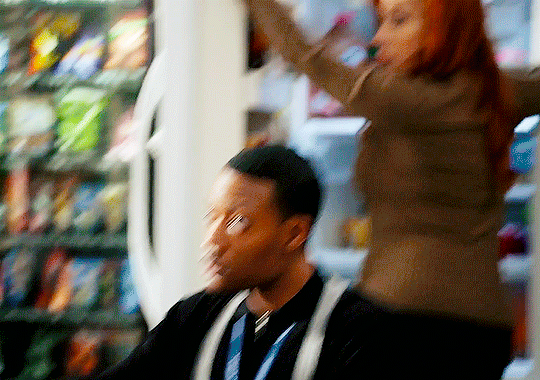
- When she hears your accent for the first time, Melissa is delighted and immediately starts trying to guess where it's from, if she can't figure out the origin on her own she'll ask you personally. You are the new temporary teacher and are at the table talking with Janine when the woman, whom you have never talked to before, sits down next to you, scrapes her throat and with a hoarse voice asks "What's up? What part of the world did this angel fly from?"
- Curious, she will ask everything about your country, from history and culture to your favorite things, this is how you slowly get closer, learning about each other during lunch breaks while enjoying company and food. She is extremely excited to try the cuisine, even more so when you describe it;
- And the food is what brings you even closer together, she rarely invites people from work over to her home, but she has simply become obsessed with a couple of typical dishes you have brought, practically begging you to come over and teach her some. It's a nice evening, drinking wine and sharing recipes;
- It becomes routine to have these evenings, on Fridays you meet in her kitchen, alternating between Schemmenti family recipes, Italian ones and your own. After enjoying the meal you have cooked together there is nothing better than watching romantic comedy movies, playing board games, doing jigsaw puzzles, or simply having a good conversation while finishing a bottle of wine;
- On one of these evenings, while you are showing pictures of your respective families and having a good time telling stories, she leans over to pour you a third wine glass, laughing at a joke with funny words in your language, and loses balance falling on top of you, eye to eye, breathing unevenly, body and breath hot. In a millisecond Melissa's soft lips are on yours, in a gentle and tender kiss that soon becomes passionate, lustful;
- After that, you can be sure, she will officially ask you to date her. Two weeks after the first kiss/night, you are at another Friday dinner, this time is different, there are candles on the table, a rose in the center, Melissa has prepared your favorite dish and is wearing a red dress that highlights each curve of her. With a cheat sheet under the table, she is asking you to date her in your first language, some of the words come out funny but it's very cute and makes your heart melt watching her roll the tongue in pronunciation. Very nervous;
- If you have trouble with english she will make sure to help whatever you need, so dedicated that she spends hours redoing exercises and reading books together, teaching you tips and tricks. She also creates ludic games for practice, personalized cards with words that you have difficulty with or want to learn;
- And she will want to learn your language, it's cute when you find her using an app, repeating the pronunciation and writing down each new thing she learns, the redhead secretly uses a children's activity book to learn the basics, it's simple, didactic and with fun illustrations;
- You will have to learn Italian anyway, at least the basics to be able to communicate with her family. She is going to teach you the essentials, like good morning, greetings, basic questions, and, especially, swearing. All Schemmenti are dirty-mouthed and also like to swear in Italian, knowing how to swear defines survival within the family;
- She loves to find out little things about you and always wonders if some habits are cultural or just something unique to Y/N, curious about every aspect of you. When you speak expressions, in less than a week she starts using them, along with usual phrases and sayings. Melissa loves to learn about your culture's typical dishes, favorite songs, hobbies and dressing customs, and may or may not acquire some of your personality by osmosis without noticing;
- If you travel to your home country she will love to know everything, taking with her travel guides and an, by the way, inseparable dictionary, the teacher refuses to ask for help with the language because she wants to show you how dedicated and good she can be speaking the idiom... but at some point Mel will, after you let her screw around while locals talk fast or expressions she doesn't recognize. It's fun and cute;
- It's a culture shock if there doesn't have a local Football team , she will question ten times if you are sure until she finally accepts. But will support whatever other sports your country has, that's what she does as a big supporter of sports in general;
- She will try everything from tourist attractions to cuisine, you might imagine that restaurants would be her weakness, but no, she will be completely obsessed with little shops and fill a bag with souvenirs for herself, family and friends. Key chains, small decorations, T-shirts, in short, everything that can remind her of your trip will be bought;
- If you bring her to a farm or something similar, well, your girlfriend becomes a total cowgirl, she likes the idea of country life, taking care of animals, enjoying the view, the nature, and, if there are crops, feeling the freshness and the taste of natural food while cooking. Maybe in the future, at some point and with someone who wants the same thing as her, Melissa will consider living somewhere like this or at least having a country house to get a taste of this tranquility;
- Pictures, lots of pictures! She will register every moment and will for sure make a special album when returning to the US, frame some of them to put on the walls, maybe even put one in her wallet along with a copy of the first picture you took together;
- And on this return trip Mel plans to ask her to move in with her, there is a special copy of the key with a keychain placed in a velvet box and when you see it your heart skips a beat imagining being asked to marry her, but you both laugh at the misunderstanding. To be clear, she is probably using a dictionary for this too... and a lot of courage.
247 notes
·
View notes
Text
THE INTERNET is designed to stop us from ever switching it off. It moves at the speed of light, with constantly changing metrics, fuelled by “‘ludic loops’ or repeated cycles of uncertainty, anticipation and feedback”—in other words, it works exactly like a Jackpot 6000 slot machine. (On a basic level, social media apps like Instagram operate like phone games. They’ve replaced classics like Snake or Candy Crush, except the game is your sense of self.) The effect of gamification on artmaking has been dramatic. In Rebecca Jennings’s Vox long read on the necessity of authorly self-promotion, she interviews William Deresiewicz, whose book The Death of the Artist breaks down the harsh conditions for artists seeking an income in the digital economy. Deresiewicz used to think “selling out”—using the most sacred parts of your life and values to shill for a brand—was “evil.” Yet this economy has made it so there’s “no choice” if you want a living. The very concept of selling out, he says, “has disappeared.” A few years ago, much was made of the fact that the novelist Sally Rooney had no Twitter account—this must explain her prolific output. But the logic is back to front: it’s only top-selling authors who can afford to forgo social media. Call it Deactivation Privilege. It’s a privilege few of us can afford, if it’s the algorithm we need to impress rather than book reviewers of old. In a nightmarish dispatch in Esquire on how hard it is for authors to find readers, Kate Dwyer argues that all authors must function like influencers now, which means a fire sale on your “private” life. As internet theorist Kyle Chayka puts it to Dwyer: “Influencers get attention by exposing parts of their life that have nothing to do with the production of culture.” The self is the work, just ask Flaubert. But data collection’s ability to reduce the self to a figure—batted about by the fluctuations of its stock—is newly unbearable. There’s no way around it, and this self being sold alongside the work can be as painful for a writer of autofiction as it is for me, a writer of speculative fiction who invented an imaginary world. ITELL YOU all this not because I think we should all be very concerned about artists, but because what happens to artists is happening to all of us. As data collection technology hollows out our inner worlds, all of us experience the working artist’s plight: our lot is to numericize and monetize the most private and personal parts of our experience. Certainly, smartphones could be too much technology for children, as Jonathan Haidt argues, and definitely, as Tim Wu says, attention is a commodity, but these ascendant theories of tech talk around the fact that something else deep inside, innermost, is being harvested too: our self-worth, or, rather, worthing. We are not giving away our value, as a puritanical grandparent might scold; we are giving away our facility to value. We’ve been cored like apples, a dependency created, hooked on the public internet to tell us the worth. Every notification ping holds the possibility we have merit. When we scroll, what are we looking for?
9 notes
·
View notes
Text
A Hundred Some New ATOM Kaiju Pt. 2
We're continuing our showcase of ATOM kaiju who've been lingering in my "to ink and color" pile for years, and yep, it's more retrosaurs. Listen, I have to draw big dinosaur monsters frequently to make life worth living, ok? We'll get to some non-retrosaurs in... part 5, probably.
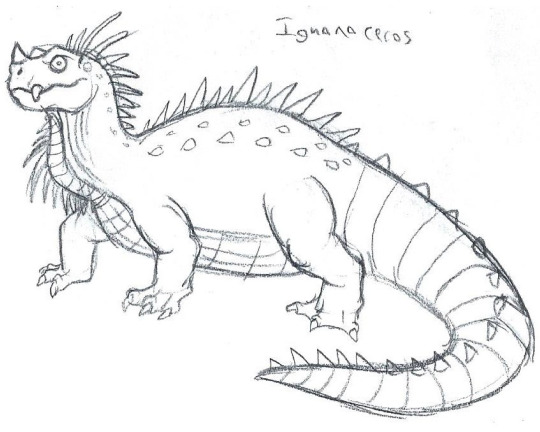
The last batch had a Crystal Palace Megalosaur-inspired kaiju in it, so we'll start this one with one inspired by the Crystal Palace Iguanodon.
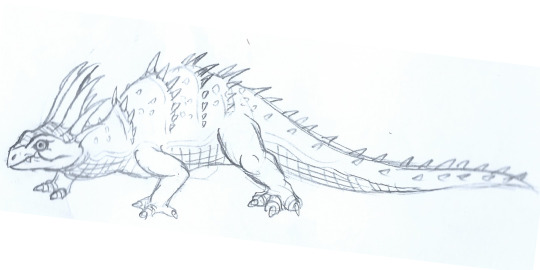
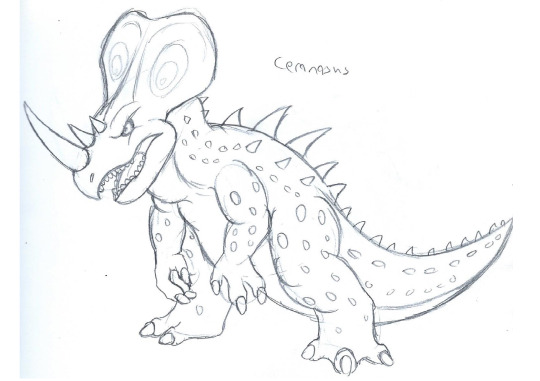
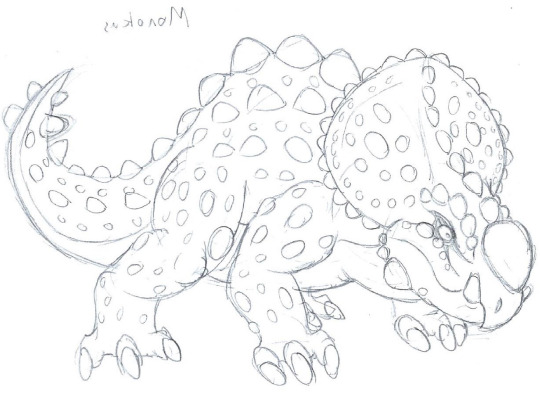
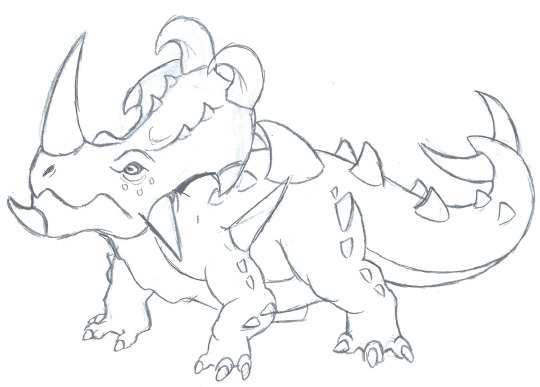

Next, some horned goliaths. The first is inspired by a very old styracosaurus toy I found that really emphasized the "lizard" approach of retro dinosaur designs, looking like a bearded dragon with an elaborate crest more than an actual styracosaur. Our second is loosely inspired by Armadon from Primal Rage and Triceramon from Digimon, being my stab at what a bipedal ceratopsian monster would look like. The remaining three are me just trying to have fun with ceratopsians the way I do with theropods.
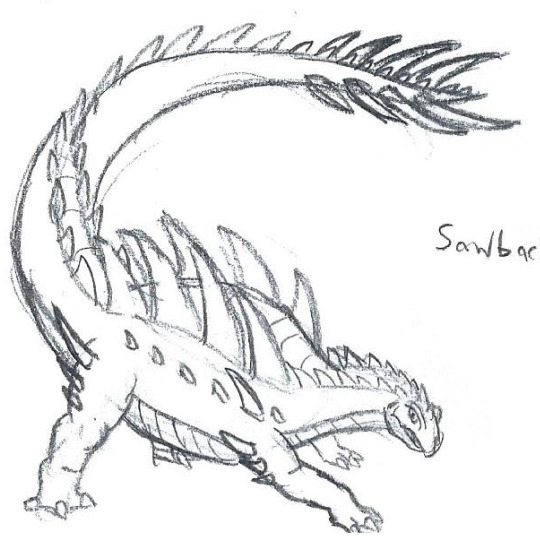

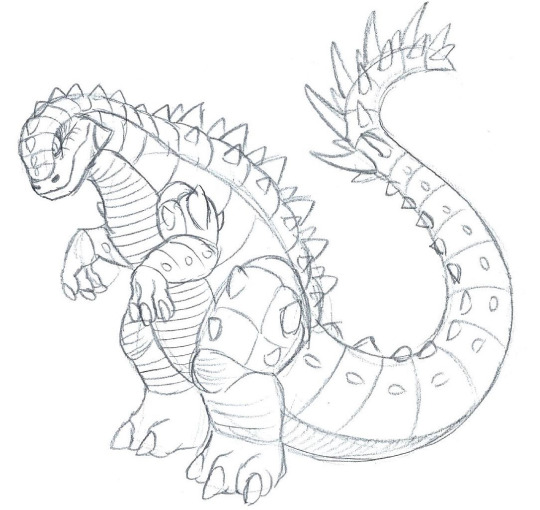
Stegronox was a fusion of stegosaur and ankylosaur traits in part to open up slots for more non-retrosaur kaiju in my cast of "core 50" kaiju for ATOM Volumes 1 and 2, so when working outside of those 50 I decided to do two retrosaur kaiju who focus on those two indvidually. The akylosaur's name is Ankylus, which is me being cheeky since that's basically what Anguirus's name would be if you translated it differently - they're both just "ankylosaurus" with a few less syllables. Then, for symmetry I suppose, I did an upright bipedal armored goliath to match the bipedal horned goliath, because "What if a four-legged creature stood on two legs" is a pretty easy way to make a monster feel distinct.
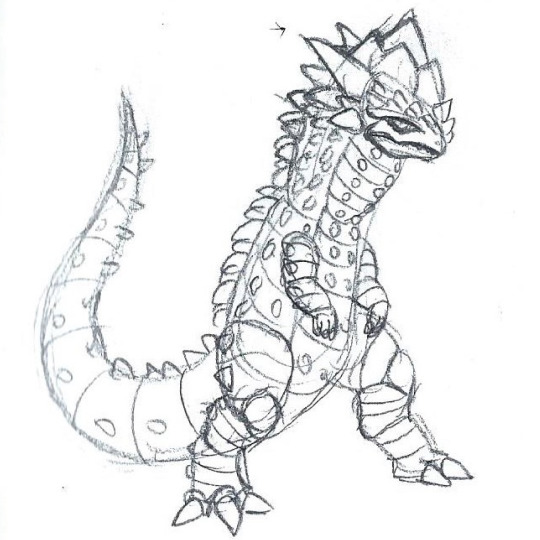
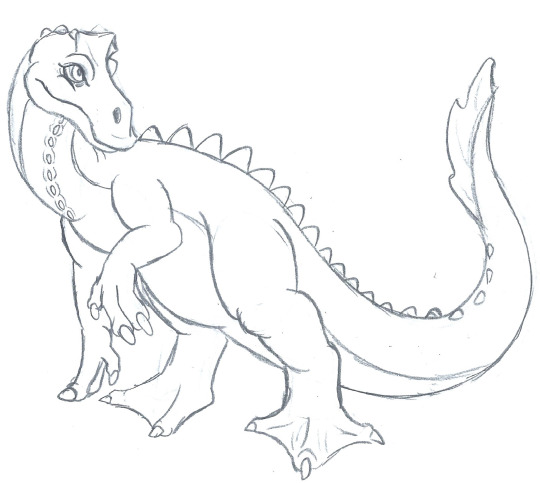
Like Stegronox, Pachydon was a combination of two different dinosaurs into one retrosaur to conserve slots in the core 50, and so I felt compelled to do two bonus retrosaur kaiju who took those two components and game them their proper due. We've got a helmeted goliath who takes the battering ram head reputation of pachycephalosaurs to a ludicous extreme, and a duckbill that particularly takes after Miasaura, which has always been my favorite hadrosaur.
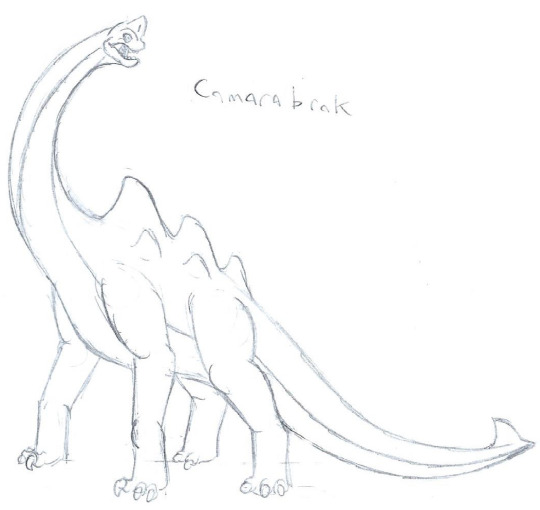
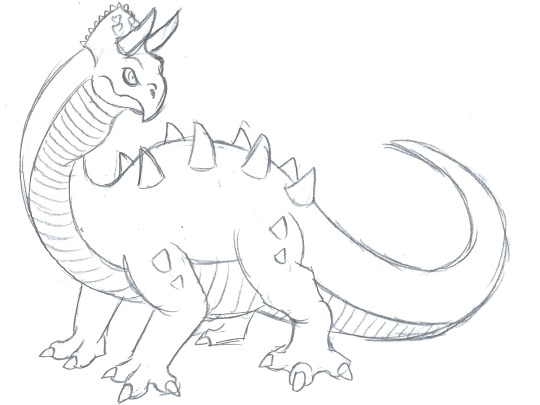
We'll close out this batch with some long-necked goliaths. The first, Camarabrak, is meant to be an equal to the other retrosaur kaiju, rather than an "immense even by kaiju standards" one like Bronton. Being bigger than big is, in my eyes, part of what makes Sauropods stand out in pop culture depictions of dinosaurs, which is why I made Bronton so tremendous compared to the others, but now that there's room for more sauropod monsters, we can have one that's in the same weight class as Tyrantis and pals.
The other long-necked goliath is Brontoceratops, which was inspired by a very early reconstruction of Triceratops (I think it may have even been by my ancestor, Edward Drinker Cope, but I can't find it anymore so who knows) that gave it a weirdly long neck. In ATOM canon, Brontoceratops's species does a sort of cuckoo-bird thing, putting their eggs in the nests of horned goliaths and letting them raise it. It'd feature in a story where Tricerak tries to find more of its kind and ends up adopting the baby Brontoceratops and raising it despite it not actually being a member of his kind.
31 notes
·
View notes
Text
For this week, we are tracking on the journey of designer-couturier John Galiano.
youtube
Source: https://youtu.be/JgRAgvWpdhs
How John Galliano changed the face of fashion...
John Galliano is a British fashion designer known for his innovative and theatrical approach to haute couture. Rising to fame in the 1980s, he became one of the most influential designers of his generation, particularly for his time as creative director at Givenchy, and later, Dior. At Dior from 1996 to 2011, Galliano infused his collections with dramatic, imaginative designs and lavish runway shows, earning a reputation for redefining high fashion with his flamboyant style and creative vision.

Source: https://www.bbc.com/culture/article/20240314-the-dramatic-rise-fall-and-rise-of-john-galliano
The turbulent journey of John Galliano’s rise, fall, and resurgence
John Galliano's first major commercial show in 1985 took a surprising turn when model Mimi Potworowska, who had purchased fresh mackerel for dinner, impulsively tossed them at the audience from the catwalk, nearly hitting fashion icon Joan Burstein, owner of the renowned boutique Browns and one of Galliano's strongest supporters. The collection, titled The Ludic Game, blended diverse inspirations: London’s pearly kings and queens mixed with forest nymphs with leafy headdresses. It was also influenced by Angela Carter's novel Nights at the Circus (1984), which features clowns, journalists, and its main character, Fevvers—a fin-de-siècle aerial performer claiming to have wings.

Some of John Galiano's creations:
For Christian Dior:

For Givenchy Haute Couture:

Linda Evangelista wearing a dress from the Givenchy Haute Couture Fall/Winter 1996 collection by John Galliano. Getty Images.
Source: https://www.lofficielusa.com/fashion/john-galliano-maison-margiela-contract-career-history-dior-givenchy
For Martin Margiela:
Galliano's work for Martin Margiela (centre) has been acclaimed, and McQueen's early work (left and right) retains its cachet (Credit: Getty Images)

Going back to his roots --- at The House of Marginal
youtube
Source: https://www.harpersbazaar.com/fashion/fashion-week/a46552616/john-galliano-maison-margiela-couture-spring-2024-show/
And his extraordinaire creations:



There's a lot more to see of John Galiano's creative allure. Follow the links below to see more of his work..
If you liked what you see in here, please leave a comment below and let me know how what and who you want to see featured. I'll be very happy to bring them on to you.
Thanks and xoxo.....
Rolando D. Suarez
email: [email protected]
------------------------------------------------------------------------------
Is Hedi Slimane Taking Over at Chanel? It’s Official—He’s Left Celine.
The fashion world is buzzing! Could Hedi Slimane be the next creative director at Chanel? Rumors are swirling, and we can’t wait to see what’s next. Known for his edgy, rock-inspired style and his game-changing work at Saint Laurent and Celine, Slimane would undoubtedly bring a bold, fresh vision to Chanel's iconic brand. Expect sleek tailoring, modern edge, and a whole new era of Chanel chic. The fashion industry could be on the verge of a major shake-up!
Source:
PARIS FASHION WEEK OCT. 3, 2024 Hedi Slimane unveils his vision for Chanel, featuring miniskirts, Fair Isle pullovers, and party shifts—paired with what may be a nod to Coco Chanel’s iconic flower
💥 #HediSlimane #Chanel #FashionNews #NewEra #ChanelRevolution #IconicFashion



Here are some of Hedi Slimane’s Best Celine Red Carpet Moments: From Lady Gaga, Kaia Gerber to Naomi Campbell and on to his Male Celebs List from Timothée Chalamet to Austin Butler.


"Like at his jobs before, Hedi Slimane wasn’t overly thirsty for celebrity placements during his tenure at Celine" . by Carolyn Twersky, Oct. 2, 2024
Image Source: MICHAEL TRAN/AFP/Getty Images

"Dakota Johnson was the first person to wear Hedi Slimane’s Celine on the red carpet, nabbing a bright red, sequin-covered mini dress for the premiere of Suspiria in 2018."
Image Source: Steve Granitz/WireImage/Getty Images

Paris Hilton’s 2023 Grammys dress, in a striking gunmetal hue, was the perfect choice for the occasion.
Image Source: Amy Sussman/Getty Images Entertainment/Getty Images

Naomi Campbell embodied pure glamour in a silver sequined gown as she graced the red carpet at the 2023 Cannes Film Festival's opening ceremony.
Image Source: Marc Piasecki/FilmMagic/Getty Images

Naturally, Slimane couldn’t resist introducing his signature sequins to menswear, creating a custom look for Timothée Chalamet at the 2024 Golden Globes.
Image Source: Gilbert Flores/Golden Globes 2024/Getty Images Entertainment/Getty Images

Austin Butler’s three-piece pinstripe suit at the London premiere of The Bikeriders exuded pure sophistication, while his steel-toe, cowboy-inspired boots brought just the right touch of rock and roll flair.
Image Source: Mike Marsland/WireImage/Getty Images

Emma D’Arcy brought their signature cool style to the New York premiere of House of the Dragon season two, rocking a Celine Homme ensemble with an embellished jacket and leather pants. Image Source: Kristina Bumphrey/Variety/Getty Images
PRODUCT RECS BELOW:







TAG US IN YOUR RECREATIONS AND INSPO PICS @celebstylefinder !
LEAVE A COMMENT BELOW WHO YOU WANT TO SEE NEXT WEEK... WE WILL BE DIVING INTO SOME MORE OF YOUR FAVORITE FASHION ICONS! UNTIL THEN...
xoxo
celeb style finder
Designer Rolando D. Suarez

Photo courtesy of Henry Nicdao, Dubai, U.A.E.
#fashion#street style#style#vintage style#mens style#celebstyle#celebritysighting#celebspotting#Youtube
2 notes
·
View notes
Text


7
Imagine your city neighborhood without cars. The sounds are returning: birds, leaves rustling, children laughing and squealing. The smells are returning too. In springtime and summer, the perfumes ofbuds and blossoms and new growth fill the air; the haze from automobile pollution is beginning to dissipate and the sky is visible again. It’s so much safer to be outside without two-ton machines whizzing by at 60 kilometres an hour. Most of the roads are breaking up from the new shoots pushing through the pavement and concrete. There are footpaths everywhere. Even bicycles seem strangely out of place.
Parks have become community gardens and orchards. Creeks and small rivers are beginning to form and re-form here and there. Someone claims that a salmon was spotted moving up a regenerating creek during spawning season. Life is returning!
Sharing and giving have become the preferred way of circulating everything. You don’t get up and head to work in a factory or a mine or in a store or for someone else’s profit. You pack a lunch and head to the garden. It’s a long day, but an enjoyable one.
There are over a hundred people in your vast community garden. Today you are all weeding and watering and mulching and repairing fences and water catchment systems. There is a playground inside it where the children play. But in every place some food is also wild crafted, gathered and fished and hunted, depending on where the city was located and on the level of knowledge of its inhabitants. Gardens need fences and constant attention. As subsistence skills spread and grow, gardens and orchards contract, making room for the expansion of dream and play time, for the nurturing and blossoming of carnal and ludic adventures.
Tomorrow is music day in the field just outside the garden. There will be a bonfire with wild meat and fish and herbs shared. What used to be a dead zone, a polluted, homogenized, top down city, a habitation without wildness, an insane density of atomized people is turning into a fascinating collection of autonomous neighborhoods and villages.
If you walk an hour south, you enter what used to be just another aspect of the same standardised urban life of producers and consumers that existed everywhere before the rupture succeeded. Now it is like going to another realm. A different etiquette, different ways of food gathering and preservation, different approaches to sexuality, perhaps even a different dialect have all been slowly emerging. Everything there is different because individuality was allowed to blossom and communal identities only take hold organically and voluntarily. One doesn’t have to travel to a faraway place for adventure, in search of diversity or difference anymore. Walk to any other village, only a couple of hours or so away and you enter a unique zone.
In the countryside, subsistence might immediately be the primary way of living. In the healing zones of formerly urban centers, permaculture might take center spot. Permaculture is a set of practices that emphasize efficiency in our food production activity. Composting human waste into manure, for instance would be such a practice. Within permaculture philosophy and practice, various food preservation techniques need to become a widespread set of cultural skills. In this sense, permaculture might be a stepping stone while crossing the turbulent waters of post-urban living.
And there are places inside the city walls where no one enters anymore. These are the dead zones. They are so polluted and ugly and unsafe to be in that long ago we piled up a mountain of rubble around them to make sure that everyone knows to stay away: a chemical factory, a prison, places of psychological ugliness and ecological sickness. This is why specific physical areas of cities will need to be abandoned, not just the urban ways that sustained them.
Whether cities were just a bad experiment and shouldn’t be repeated, or whether they were an imposition of forces opposed to genuine living, re-forming them can’t be part of the solution. Transformation will be the healing medicine this time. Our land bases will be places where experiments in living are a constant opportunity.
#freedom#ecology#climate crisis#anarchism#resistance#community building#practical anarchy#practical anarchism#anarchist society#practical#revolution#daily posts#communism#anti capitalist#anti capitalism#late stage capitalism#organization#grassroots#grass roots#anarchists#libraries#leftism#social issues#economy#economics#climate change#climate#anarchy works#environmentalism#environment
2 notes
·
View notes
Text
Bloodborne: A Study of Environmental Narratives and Ludonarrative Harmony.
VII. Conclusion
While this paper only addresses Bloodborne as far as concerns about ludonarrative harmony go, that is far from the extent of the concept’s applications within the field of video game studies going forward. Engaging with games and looking for this blending between the ludic and narrative elements proves fruitful as an exploration of developer intention and whether or not those marks have been missed. Without ludonarrative harmony, players are faced with disjointed and un-immersive experiences in their narrative games. Games that deemphasize narrative are, of course, less concerned about ludonarrative harmony, though the vast majority of things being produced by gaming companies as of this paper’s writing to involve some form of narrative progression.
To summarize, Bloodborne gives its players a sense of harmony between its narrative themes and its gameplay by blending its environmental storytelling, narrative elements, and gameplay into a cohesive whole. This paper looked at how each of these elements worked, moving from the most broad, environmental storytelling, to the most complicated and narrow, ludonarrative harmony. Through an exploration of the narrative expectations of Bloodborne and comparing those with the gameplay, we can see that the game emphasizes its narrative themes throughout the play experience by utilizing elements like health damage, enemies, and item descriptions to effectively blur the line between what is narrative and what is gameplay.
Bibliography
Aarseth, Espen. “A Hollow World: World of Warcraft as Spatial Practice.” In Digital Culture, Play and Identity: A World of Warcraft Reader, edited by Hilde G Corneliussen and Jill Walker Rettberg, 111–22. Cambridge, MA: MIT Press, 2008.
Christopher, David, and Aidan Leuszler. “Horror Video Games and the ‘Active-Passive’ Debate.” Games and Culture, April 27, 2022. https://doi.org/10.1177/15554120221088115.
FromSoftware. Bloodborne. Bandai Namco. Xbox One/PC/PlayStation. 2015
Green, Amy M. Storytelling in Video Games. McFarland, 2017.
Grodel, Torben. “Video Games and the Pleasures of Control.” Media Entertainment, 2000, 209–26.
Hocking, Clint. “Ludonarrative Dissonance in Bioshock.” Click Nothing, October 7, 2007. https://clicknothing.typepad.com/click_nothing/2007/10/ludonarrative-d.html.
Jenkins, Henry. “Game Design as Narrative Architecture.” In First Person: New Media as Story, Performance, and Game, edited by Pat Harrington and Noah Frup, 118–30. Cambridge, MA: MIT Press, 2004.
Kirkland, Ewan. “Storytelling in Survival Horror Video Games.” In Horror Video Games: Essays on the Fusion of Fear and Play, edited by Bernard Perron, 62–78. Jefferson, NC: McFarland & Company, 2009.
Kocurek, Carly A. “Who Hearkens to the Monster’s Scream? Death, Violence, and the Veil of the Monstrous in Video Games.” Visual Studies 30, no. 1 (January 2, 2015): 79–89. https://doi.org/10.1080/1472586x.2015.996402.
Krzywinska, Tanya. “Blood Scythes, Festivals, Quests, and Backstories.” Games and Culture 1, no. 4 (October 2006): 383–96. https://doi.org/10.1177/1555412006292618.
Ruberg, Bonnie. Video Games Have Always Been Queer. New York: New York University Press, 2019.
Ryan, Marie-Laure. Narrative as Virtual Reality 2: Revisiting Immersion and Interactivity in Literature and Electronic Media. Baltimore: Johns Hopkins University Press, 2015.
Soriani, Alessandro, and Stefano Caselli. “Visual Narratives in Videogames: How Videogames Tell Stories through Graphical Elements.” Img Journal 3 (2020): 474–99.
Thon, Jan-Noël. “Transmedial Narratology Revisited: On the Intersubjective Construction of Storyworlds and the Problem of Representational Correspondence in Films, Comics, and Video Games.” Narrative 25, no. 3 (2017): 286–320. https://doi.org/10.1353/nar.2017.0016.
Wolf, Mark J. P. “Beyond Immersion: Absorption, Saturation, and Overflow in the Building of Imaginary Worlds.” In World Building, Transmedia, Fans, Industries, edited by Marta Boni, 204–14. Amsterdam: Amsterdam University Press, 2017.
#video games#fromsoftware#fromsoft games#soulsborne#elden ring#dark souls#bloodborne#unpacking#2023 Work#Ludonarrative harmony#environmental storytelling#Bloodborne: A Study of Environmental Narratives and Ludonarrative Harmony#graduate school#grad student#Graduate research
2 notes
·
View notes
Text
Reader
1.
Gil-Aciron, L. A. (2022). The Psychology of Gamers: Psychological Perspectives on Game Design and Gamification. Interactive Learning Environments, 32(1), 183–207. Available at: https://doi.org/10.1080/10494820.2022.2082489
This study delves into the psychological foundations of game design and gamification, analyzing how game mechanics and dynamics shape player engagement, motivation, and emotions. Drawing on theories such as self-determination and flow, Gil-Aciron highlights the mechanisms that sustain player interest and emotional connection. Practical applications of gamification beyond gaming, such as in education and workplace productivity, are also explored through real-world examples.
From my perspective as a concept artist, this research highlights the importance of psychological principles in creating immersive game environments. The paper's insights into intrinsic motivation and reward systems inspired me to integrate these concepts into my design, and in Assignment 4, Concept Art - Light and Shadows, I also tried to create an environment that emotionally resonates with the player to increase the expressiveness of the work.
2.
Hernández-Pérez, M. (2024). Video Game Characters and Transmedia Narratives. Review of Dynamic Game Characters by J. Blom. Popular Communication, 22(3), 200–202. Available at: https://doi.org/10.1080/15405702.2024.2393240
In reviewing Dynamic Game Characters, Hernández-Pérez explores how video game characters evolve dynamically through player interaction and connect to transmedia storytelling. The review commends Blom's integration of theory and practical examples but critiques the limited case studies. The book emphasizes how characters develop across platforms, enriching narratives and deepening audience engagement.
This resonates with my philosophy of character design, as character-driven storytelling directly impacts the atmosphere and narrative coherence of the game world. When I designed a character in Assignment 5, Using a "bit" of 3D, I didn't just design her look, I also tried to build a unique character based on her personality and experience, so as to enhance the depth of the narrative and the player's immersion.
3.
McCrea, C. (2017). The Progressive Revelation of Pokémon: 20 Years of Game Design Notes. Mobile Media & Communication, 5(1), 42–46. Available at: https://doi.org/10.1177/2050157916678271
McCrea examines the Pokémon franchise’s gradual evolution, detailing how incremental innovations in mechanics and themes have sustained its popularity over decades. The analysis highlights how each generation balances tradition with novelty, fostering nostalgia while engaging new audiences. Pokémon’s adaptability, particularly in mobile media like Pokémon GO, is also discussed.
This insight into incremental design is very inspiring to me, especially when it comes to conceptualizing an ever-evolving environment today. The balance between tradition and innovation has inspired me to think about my own culture when I was designing concepts, and in my work Assignment 3, Concept Art - Nostalgia and Memory, I try to tell the story of the Chinese Lantern Festival to create spaces that are both familiar and surprising, to add depth and uniqueness to my work.
4.
Kirkpatrick, G. (2007). Between Art and Gaminess: Critical Theory and the Aesthetics of Computer Games. Thesis Eleven, 89(1), 74–93. Available at: https://doi.org/10.1177/0725513607076134
Kirkpatrick investigates the unique fusion of art and interactivity in computer games, proposing alternative frameworks for evaluating their aesthetic merit. The paper emphasizes how games’ ludic and participatory nature differentiates them from traditional art forms, discussing their cultural and societal significance.
This study encourages me to view game environments as more than visual elements—they are integral to player engagement. It inspired me to create designs that are not only beautiful, but also closely related to the game mechanics and narrative, and I was trying to better consider the usefulness and operation of each part of the character in the drawing process when I designed the character in Assignment 5, Using a "bit" of 3D, which I think was an important experience and inspiration for me.
5.
Tompkins, J. E., & Martins, N. (2022). Normalized Practices of Male Pleasure: Character Design in the Video Game Industry. Games and Culture, 17(3), 399–420. Available at: https://doi.org/10.1177/15554120211034760
In this article, Tompkins and Martins critically analyze character design in the video game industry, focusing on how male pleasure is embedded in the normalized practice of game development. Through an examination of visual and narrative elements, the author reveals how a male-centric perspective influences the portrayal of characters, often prioritizing male pleasure and perpetuating gender stereotypes. The authors argue that the industry's reliance on these normalized practices not only limits the diversity of role representation, but also reinforces broader social power dynamics. This research encourages reflection on the ethical responsibility of game designers in creating inclusive and equitable narratives.
This is in line with my idea of designing characters and environments that reflect different experiences, conceptual design is undoubtedly free, and as a conceptual designer, I hope to think more about going beyond the traditional social perspective in the future to create a more inclusive and equitable gaming culture.
6.
Klapztein, S., & Cipolla, C. (2016). From Game Design to Service Design: A Framework for Gamified Services. Simulation & Gaming, 47(5), 566–598. Available at: https://doi.org/10.1177/1046878116641860
Klapztein and Cipolla explore the intersection of game design and service design, proposing a comprehensive framework for developing gamified services. By integrating principles of game mechanics and user engagement, the authors offer insights into how gamification can enhance service experiences across various industries.
The article emphasizes the importance of balancing playful elements with functional objectives to create meaningful and sustainable user interactions. Through detailed case studies, the authors illustrate how their framework can be applied to design services that not only entertain but also motivate and educate users.
This inspires me to explore gamification in visual storytelling, designing environments that integrate playful, engaging elements while maintaining narrative depth.In Assignment 3, Concept Art - Nostalgia and Memory, I not only consider the picture effect when creating, I also try to integrate the story behind the picture into the scene to increase the narrative of the story.
7. Kirkland, E. (2010). Constructing the Art of Silent Hill as a Discourse. Games and Culture, 5(3), 314–328. Available at: https://doi.org/10.1177/1555412010364976
Kirkland examines Silent Hill as a cultural and artistic phenomenon, highlighting its use of visual design, soundscapes, and symbolic narratives to explore psychological depth. The series blurs the lines between popular culture and artistic expression, offering unsettling yet profound experiences.
This study inspires concept artists to evoke emotional and psychological responses through design. It motivates me to combine surreal and realistic elements to create immersive environments that deeply resonate with players.The monsters I created in Assignment 1, Concept Art - Creating "Concepts" try to arouse the audience's emotional resonance through their shapes, so as to achieve the horror effect I wanted.
8. Jones, M. (2007). Vanishing Points: Spatial Composition and the Virtual Camera. Animation, 2(3), 225–243. Available at: https://doi.org/10.1177/1746847707083420
Jones explores the role of virtual cameras in digital spaces, focusing on how spatial composition influences storytelling and emotional engagement. By blending traditional cinematography with dynamic framing and interactive perspectives, the study highlights their impact on narrative clarity and player focus.
This encourages concept artists to consider virtual camera placement when designing, ensuring visually compelling and narratively cohesive environments that support gameplay and storytelling.This article gave me a lot of inspiration and ideas, and the storyboards I created in Assignment 5, Concept and Storyboards, the power-couple! paid special attention to the narrative and interactivity of each shot, and it was a good result.
9. Van Rooij, M. (2019). Carefully Constructed Yet Wonderfully Real. Animation, 14(3), 191–206. Available at: https://doi.org/10.1177/1746847719875071
In this article, van Rooij explores the character design strategies employed by major American animation studios to evoke empathy in audiences. The author identifies common stylistic elements—such as exaggerated facial features, expressive eyes, and relatable body language—that transcend individual productions and foster an emotional connection with viewers.
The article also considers the balance between stylization and realism in character design, emphasizing the importance of achieving both visual appeal and emotional resonance.
For me, this research reminded me of the need to be able to balance visual appeal and emotional resonance when designing characters. Inspired by this, I designed each of the characters in Assignment 2, Concept Art - Human and "Inhuman" with their keyword anchors, trying to make them distinctive and visually expressive.
10.
Friedman, A. (2015). The Role of Visual Design in Game Design. Games and Culture, 10(3), 291-305. Available at: https://doi.org/10.1177/1555412014559977
In this article, Friedman examines the critical role of visual design in shaping the player experience within video games. The author argues that visual design is not merely an aesthetic consideration but a fundamental component of gameplay, narrative communication, and player immersion.
Friedman delves into how elements such as color, composition, and iconography contribute to intuitive user interfaces, emotional engagement, and world-building. The article also highlights the collaborative nature of game development, where visual design must integrate seamlessly with storytelling, sound, and gameplay systems.
Friedman’s insights inspire me to consider not only the artistic quality of my designs but also their functional and narrative impact.After this paper, I also paid more attention to the role of visual elements such as color composition in the overall character concept in my work, which deepened my understanding of conceptual design and helped me to better complete my work.
0 notes
Text
Even though it contains one of the most unmistakably alive and technically impressive of all simulated open-worlds, Red Dead Redemption 2 (RDR2) from the Rockstar Games company is still far more than it appears on the surface. In the game, the player is asked to make choices for Arthur Morgan that prove he or she to be ‘good man’ or a ‘bad man.’ This blog post will briefly outline how RDR2 addresses political, cultural, and social issues, using the open-world structure, honor system mechanics, and narrative to deliver a message that challenges the audience to do introspection that ultimately calls for a reconsideration of how they engage with the world.

RDR2’s gameplay includes a first-person shooter, an honor mechanic, and a simulation. These parts allow for combat, narrative consequence, exploration, and sandbox gameplay respectively. Bogost (2008, p.121) will remind game scholars that rules do not simply allow one to experience play, but they also create the significance of the game overall. Because a player’s gameplay decisions directly influence how the story unfolds, ludic and narrative mechanics are deeply intertwined. They are arguably essential to one another, resulting in a rounded reflection of a player's moral and ethical relation to the world. This idea is particularly applicable to RDR2’s simulation- subjectively, it is as close, visually, as it gets to the real world. The attention to detail, visual richness, and sound all lead to an experience in which it is easy to suspend disbelief. This suspension of disbelief feels as if it heightens the impact of the game’s message. That is not to say that a visually realistic simulation is the only kind of game that is immersive- these things are not mutually exclusive. Beyond the instinctive feeling of awe when playing RDR2 is a broad feeling of empathy and maybe some existentialism. Immersion is a feeling you can get from text, it doesn't have to have anything to do with how something looks or sounds.

“Arthur Morgan: You don’t get to live a bad life and have good things happen to you” (Rockstar Games, 2018).
In RDR2, the combination of ludic and narrative gameplay prompts players to reflect on the tension between their personal values and cold pragmatism. Should a player rob a train for money which could result in innocent deaths? Does the player kill when there is nobody around to witness it? Does the player feel guilt and responsibility hurting people, or do they just take what they want? The game world certainly has a response to ‘bad’ Arthur Morgan. The entire tone of the game shifts if it is being shaped by negative choices. There are too many examples to begin to list, but NPCs will react poorly to Arthur, being unwilling to sell to him, buy from him, or be otherwise friendly. Even Arthur will react poorly to himself, as his dialogue becomes cruel and his appearance changes. There are additional visual and sound indications of low honor, one of which is the deadeye mechanic which changes in color and sound. With violence being an essential aspect of RDR2, the honor mechanic reminds players that while they have freedom in the lawless frontier, they are not free from the consequences of their actions. The player will have to weigh internal satisfaction and restraint against practical advantage and internal and external conflict.

In real life, being a ‘good man’ is not necessarily guaranteed to be rewarded, and it can feel disadvantageous at times. The single apparent advantage to a low honor play-through is material reward. It is understood that the transition from freedom and lawlessness to a regulated and industrialized society is a theme throughout RDR2.
“Arthur Morgan: Who is Leviticus Cornwall?
Hosea Matthews: He’s a big railway magnate, sugar dealer, oil man.
Dutch van der Linde: Well, how good for him. Sounds like he has more than enough to share. (loudly) Gentlemen, it is time to make something of ourselves. Get your horses ready, we have a train to rob” (Rockstar Games, 2018).
While Dutch and the gang make every effort to be one step ahead, the growing pressure of capitalist and corporate control threaten to swallow them whole- Leviticus Cornwall is meant to be an embodiment of capitalism, and this is how RDR2 turns capitalism into one of the greatest antagonists in the game, only behind Dutch and Micah- who are the embodiments of greed and violence respectively. The O'Driscoll's are a kind of nod towards classic western villainy, but it has made clear that Dutch’s gang have more in common with their rival than they would care to admit.
“Arthur Morgan: We’re thieves in a world that don't want us no more” (Rockstar Games, 2018).
Players can feel the squeeze of industrialisation and Capitalism when visiting the city of Saint Denis. NPCs will call out to Arthur, who sticks out like a sore thumb, inquiring if he is lost, teasing him for being a cowboy and for not fitting in.

While RDR2 does not completely escape gender roles, it presents a relatively balanced power distribution between genders. “Most common ways of stereotyping in video games are “damsels in distress” and sexual objectification… In these kinds of games, women are dressed in provocative clothing and are created to serve males as an aid or even as a sexual object. As an example, Grand Theft Auto III Vice City allows the player’s character to have sex with a prostitute, afterwards kill her, and from this act get a health bonus” Kondrat (2015, p.172). Sadie Adler disrupts typical expectations of femininity, being seen as one of the gunslingers without question and represents often more of a threat in combat than the rest of them. An overt sexualisation of female characters in RDR2 is not as blatant as it was in Rockstar’s earlier games. Though Tilly and Abigail still conform to societal expectations of beauty, they are dressed in clothing which respects the period, and they are seen as members of the gang without question.
Stepping into this open world, it may initially seem to be merely providing adventure or exploration- but under the surface, it reflects the game’s designers and their views about the world. In conclusion, RDR2 is a game which explores issues through an open-world simulation, using morality-weighing game mechanics to communicate a message which forces the audiences into introspection about themselves and the world.
Bibliography
Bogost, I., 2008. The rhetoric of video games. In: MacArthur Foundation Digital Media and Learning Initiative, ed. The impact of digital media on learning: Perspectives from the field. pp. 117-140.
Frasca, G., 2013. Simulation versus narrative: Introduction to ludology. In: M. J. P. Wolf and B. Perron, eds. The video game theory reader. Routledge, pp. 221-235.
Kondrat, X., 2015. Gender and video games: How is female gender generally represented in various genres of video games?. Journal of comparative research in anthropology and sociology, 6(01), pp.171-193.
Rockstar Games, 2018. Red Dead Redemption 2. [video game] Available at: https://www.rockstargames.com/reddeadredemption2 [Accessed 1 December 2024].
1 note
·
View note
Text
Carmelo La Gaipa
Ludic Minimalism
Carmelo La Gaipa | " TODAY RAIN IN MILAN " #ludicminimalism#urbanart#streetart | Instagram
Milan street artists Carmelo La Gaipa threw a pool of water on the ground and put a lot of paper, on the surface of the water in the low water near the beach in Italian, French and English, respectively, to write the names of the work, puddle shipping company, and the work he would like to emphasize, Gaming Minimalism (Ludic Minimalism) this streamlined and pure art, easy and routine of the two elements, water and paper put in a busy city background, the traces of artist in work is reduced, works his own existence and the surrounding environment and the relationship between the audience in the face of work experience was outstanding. It is Ludic Minimalism that a shipping company's ship, which should be based on the sea, is now huddled in this puddle of water.
The artist cleverly maximizes the impact on the space with minimal material use, successfully attracting the attention of countless passers-by with a simple beach and a few paper boats in a busy neighborhood of Milan. The artist, who can be seen on his social media account, also hands out special fishing rods to 'catch' the boats, in the form of a simplified stick. Minimalist works often encourage the observer to interpret them for themselves, to make connections and give meaning to the work, all relying on their own past experiences and feelings. The microscopic and comical expression of the artist's grand narrative reminds me of the modern expression of minimalism in the Song Dynasty. I have always hoped that some elements of traditional Chinese culture can reasonably appear in my works, because this means the background of my creation and the culture I rely on.
0 notes
Text
Lazy Ludics
Jacob Geller, a video game and cultural essayist on Youtube, recently published a video called "Analyzing Every Torture Scene in Call of Duty - All 46 of Them," which does just as the title describes. His focus hones heavily in on the narrative aspect of these torture scenes and the "effectiveness" of torture in-text via the prescribed morality of the torturer. One element Geller misses, though, is the ludic aspect of these torture scenes. Call of Duty participates in the long (relatively speaking) legacy of video game violence with clumsiness, as Geller discussed in a previous video essay, "Does Call of Duty Believe in Anything?" and the acting out of violence in video games sets gaming apart in depictions of violence in both audience experience and cultural perception. The gameplay of Call of Duty in its simplest form is shooting guns, dodging bullets, and selecting weapons. Attempts to extend narrative gameplay bring about lexicon-altering ridicule -- the gaming slang of "F" to ironically "pay respect" derives from Call of Duty: Advanced Warfare's prompt of "Press F to pay respects" during a funeral.
The player, as shown in Geller's video, is prompted in one of the Call of Duty games to dodge being waterboarded by simply pressing a key. While all gaming comes down to pressing keys, clicking mice, and turning joysticks on a physical level, the player cannot contribute to the narrative here with meaningful amounts of skill. This stands in opposition to the rest of the gameplay, where reaction time and practice makes the player character meaningfully more strong to the player. The infamous "Press F to pay respects," if ignored, just stalls the game indefinitely. A more generous reading could argue that the player's inability to use physical skill to power through torture creates a form of ludic vulnerability. What I see is the game's inability to see beyond violence. Only violence can require skill. Everything else, like speaking, paying respects, and being tortured, is unskilled.
Games, as an active medium, must value activeness and skill in a way that other mediums cannot. The player must always be protagonist. However, engaging with games does not require this active playing. The genres of online gaming video allow for a type of participation not built into the game itself, one that cannot carry all of the medium's emphasis on activeness. In viewing someone else play, the audience of the video becomes like the audience of a film. Not burdened by being protagonist allows the viewing audience to gain another perspective on the game and how the ludic elements work.
When I was a child, my father nearly bored me to death by playing Call of Duty: Black Ops. Without the ludic elements, nothing captured my attention or felt meaningful. Part of this was due to my age, but now, part of my past boredom clicks. A game that narratively prizes activeness so much loses much of its meaning when viewed without the ludic elements. Call of Duty gaming videos abound online, as for players of the series, ludic information can still be conveyed. A viewer with no context of the ludic qualities of Call of Duty, like myself aged eight, will find a game that spiritually chastises them for doing nothing. The series' military fetishization and gameplay sides with the philosophy of acting upon others before they act upon you. Its handling of neo-colonialism and the West's imposition on the rest of the world is meant to leave the player aching to be the one blunt-hammering and subjugating. Nothing is worse in Call of Duty's gameplay than sitting and doing nothing. It is equivalent to torture.
1 note
·
View note
Text
Blog #9: The Conscious Intertextuality of the "Fate" Franchise
The Fate series has become a multimedia sensation and is an example of deliberate intertextuality in modern Japanese popular culture. This franchise intentionally uses intertextual techniques to build a rich world of storytelling that interacts with literary, mythological and historical elements.
One of the best examples of "playful intertextuality" in modern media franchises is the central idea of the Fate series, where historical figures are used as "servants" in a battle royale. By reinterpreting historical figures, it encourages viewers to interact with familiar stories in new ways.
These characters are often reinterpreted in the franchises with a gender swap and anachronistic features. This approach challenges the standard representations of historical figures and creates a unique mix between historical narratives and contemporary themes.
It also makes use of transmedia intertextuality with the use of different dimensions and timelines. These franchises build a web of interconnected texts makes the audience actively participate. This strategy follows the typical patterns of contemporary media franchises.
The franchise's engagement with literary traditions goes beyond the inclusion historical figures. The series intentionally places itself within a variety of fantasy literature.
The Fate franchise is an example of the potential of intertextual techniques to create complex, compelling worlds. It serves as an example of how sophisticated storytelling techniques can be used in contemporary media to create compelling worlds.
References:
Kobayashi, H., 2023. Meta-Narratives and Self-Reflexivity in Contemporary Anime Franchises. Journal of Japanese and Korean Cinema, 15(2), pp. 189-210.
Nakamura, S., 2022. Ludic Intertextuality: Playing with History and Myth in Japanese Video Games and Anime. Games and Culture, 17(2), pp. 165-185.
Tanaka, M., 2024. Fantasy Traditions and Innovation in Contemporary Japanese Media. In: R. A. Reid and M. J. Wolf, eds. The Routledge Companion to Imaginary Worlds. New York: Routledge, pp. 45-62.
0 notes
Text
Reader
Adams-Bass, V. N., Bentley-Edwards, K. L., & Stevenson, H. C. (2014). That’s Not Me I See on TV . . . : African American Youth Interpret Media Images of Black Females. Women, Gender, and Families of Color, 2(1), 79–100.
The article showcases how portrayals of black women in popular media are perceived by young African-American students. The authors find that an overwhelming majority of the target audience find many images of black women in media offensive, negative and false. The study argues that such trend can have a detrimental effect on how the community views black women and may promote negative stereotypes further damaging the sense of perception of people’s own identity. I found this research highly valuable, as a media creator myself it is important for me to portray demographic groups with accuracy and respect. It is necessary to critically analyze media portrayals and their reception in order to grow and learn from mistakes and implement a positive portrayal that will be accepted by communities.
2. Balela, Majed S. and Darren P. Mundy. (2015) “Analysing Cultural Heritage and its Representation in Video Games.” DiGRA Conference.
The article sheds light into the relationship between cultural heritage and video games, analyzing how video games have become platforms to showcase various cultures and history of real life people. The authors use “Assassin’s Creed 1” as an example of how game developers approached representing the Middle Eastern culture in the game. Game development process in some instances can take years and require the help of historic specialists if the developers want to make an accurate portrayal of any culture. I believe that video games have the capacity to preserve cultural heritage and it is important to represent cultures properly and accurately.
3. Biscop, K., Malliet, S., & Dhoest, A. (2019). Subversive Ludic Performance: An Analysis of Gender and Sexuality Performance in Digital Games. DiGeSt. Journal of Diversity and Gender Studies, 6(2), 23–42.
The article explores how certain games allow their players not to conform to heteronormative roles by blurring the lines in terms of sexuality and gender. Despite broader representation of LGBTQ+ community in the game industry, the romance options still feel limited as they are usually created as part of the story narrative. The authors bring examples of The Sims video game franchise and Life is strange. They analyze how these games are fostering diverse gender performances. In the Sims, the player has the freedom of choice and can develop romantic relationships with characters of any gender. Life is Strange allows players to pursue male and female characters as well. This theme is essential for those who want to create meaningful game narratives that can accommodate feelings of a wider audience that will feel connected due to related experience.
3. Dasu, Keshav & Kuo, Yun-Hsin & Ma, Kwan-liu. (2023). Character-Oriented Design for Visual Data Storytelling. IEEE Transactions on Visualization and Computer Graphics. PP. 1-11.
The authors of this article argue that the story is told through the characters and that they are the key elements in a narrative. They have analyzed more than 160 data stories where they identified features that distinguish characters in media. It is said that story telling narrative can be expanded through the character design as the medium creator can incorporate various symbolism and meanings into that said design. As a concept artist I could relate to the ideas in the article as I focus on character design and believe that a good design carries meanings and extends the narrative.
4. EMERSON, D. L. (2019). Mythology in Children’s Animation. Mythlore, 38(1 (135)), 259–266.
This article explores the way different mythologies are portrayed in visual media for children. Some cartoons may have only subtle elements of mythology – for instance “The Little Mermaid” or “Aladdin”, where as others can be solely built around a certain mythology. The prime example of that could be the animated movie by Disney “Hercules” based on ancient Greek heroes and myths. The author argues that such experience can have a positive effect on the younger audience as mythological symbolisms in children’s cartoons pave way to teaching children more philosophical advanced themes. I feel that folklore and mythology are timeless concepts and make great media narratives for people of all ages.
5. Lynch, T., Tompkins, J. E., van Driel, I. I., & Fritz, N. (2016). Sexy, strong, and secondary: A content analysis of female characters in video games across 31 years. Journal of Communication, 66(4), 564–584
The article analyzes the way the portrayal of female characters in games has shifted within the time period between 1983 and 2014. The authors found that through the years the sexualization of female characters in video games has diminished, however secondary female characters are still often portrayed in an objectified way. It was also revealed that sexualized female characters are more present in the game genres that are more associated with being male-oriented, such as fighting games like Mortal Kombat or Street Fighter.The authors also conclude that sexualization is not the contributing factor of success and that there is a positive progress made in the gaming industry. As a woman, I found the research educational. As someone who wants to pursue working in the games industry I find it my mission to portray female characters in a respectful way that would foster positive portrayal and role models for people.
7. Marie-Laure Ryan. (2015). Transmedia Storytelling: Industry Buzzword or New Narrative Experience? Storyworlds: A Journal of Narrative Studies, 7(2), 1–19.
The research in this article explores transmedia storytelling. The author mentions such popular media as “Star Wars” by George Lucas, “A song of Ice and Fire” by G. R. R. Martin and “Lord of The Rings” by J. R. R. Tolkien and says that these well known works are immensely successful and can serve as proof of transmedia storytelling being the most crucial form of storytelling. However, the author argues that the expansion of a medium should be dictated by the necessity in storytelling rather than marketing strategy. She believes that the audience will be more interested in continued form of media rather than something new – for example comic book fans are more excited about a new comic book issue rather than a TV show based on that. The article is highly relevant as today the media space seems to be dominated with big franchises whose narratives transcend various forms of media, such as Marvel.
8. Nyssen, L., & Harris, R. P. (2018). Storytelling in Siberia: The Olonkho Epic in a Changing World. The World of Music, 7(1/2), 215–219.
The article explores how the Native Siberian Sakha people are keen on maintaining their epic folklore Olonkho despite Russia's policies to erase native peoples of their identities. The epic is an ancient set of poems of great heroes that existed in oral form. Nowadays, successful revival attempts have been made: the epic Olonkho has been adapted across different forms of media, such as cartoons, written novels and even games. The author argues that the deliberate attempts of such a small-sized nation implementing cultural elements in their day-to-day lives have played a signifcant role in maintaining the sense of identity and helped to preserve the unique Arctic culture. This research is extremely important to me as a Sakha person, I believe that the traditions and culture of native people are underrepresented in media and maintaning them in forms of different media is essential for shaping the sense of identity for future generations.
9. Przybylski, A. K., Weinstein, N., Murayama, K., Lynch, M. F., & Ryan, R. M. (2012). The Ideal Self at Play: The Appeal of Video Games That Let You Be All You Can Be. Psychological Science, 23(1), 69–76.
The article questions the reasons behind immense popularity of video games and asks what the driving factors behind their appeal are. The authors of the article argue that due to immersive nature of video games people are able to visualize the idealized version of themselves and accomplish things in the virtual environment that they are not able to do in real life. Thanks to direct interaction with the in-game world players are able to fully immerse themselves and develop a strong affective connection with the narratives portrayed in video games. The study conducted in this article is conclusive, tackles relevant issues in the gaming industry and gives coherent answers.
10. Totten, C. W. (2017). Game Levels as Works of Art, Architecture, and Design. In T. Funk (Ed.), Video Game Art Reader: Volume 1 (pp. 11–18). Amherst College Press.
In this article the author compares intricately and skillfully designed game levels in video games to architecture. He introduces the concept of “architecture as affect", stressing that architectural decisions are capable of invoking emotional response from people and adding to aesthetical pleasure arguing that some game levels have advanced to a point where they can possess the same qualities. Therefore, game levels could be viewed as work of art. What makes this form of art stand out from other traditional art media is that the viewer or the player in this case is able to directly interact with space environment in level designs sometimes even changing and altering it. I found the article interesting as my specialty lies in the intersection of game levels design and can be helpful to better understand how to implement concepts that are found in more conventional forms of art into my work.
0 notes
Text
Academic Blog 7
In a game with a narrative, characters are the driving force. Their aims, abilities, and experiences become the players' abilities and goals. The game What Remains of Edith Finch (2017), a critically acclaimed game for its narrative, is a first-person exploration video game that explores the tales of members of the Finch family. Every story is strange and specific to the family member it pertains to. The game combines ludology and literary structures to create an engaging narrative game.
The game can be seen as a collection of short stories within a main narrative where the protagonist returns to her family home to find out what led to the strange deaths of her family members. Bozdog and Galloway (2020) argue that this structure has been derived from a literary technique called “frame narrative” by developing a collection of stories within a story within a story. The game combines literary structures with game mechanics to produce a fascinating experience for the player. The texts in the game appear and fade away as the player is transported from one narrative to another.
Each story in the game has its unique genre reflecting the personality of the family member. Barabara, a child actress who became popular through horror movies, is given a plot that perfectly fits the classic horror genre. The tale of Gus and Gregory shows how the game utilises literary texts in its game mechanics. Just like how the curiosity of the two leads to their demise, the texts to be read appear near objects making the player curious about how the story progresses and eventually reaches their end by interacting with them. The interesting combination of ludology and narratology makes the player experience unique. Bozdog and Galloway (2020) support this by saying that ‘The players are invited to deploy literary and ludic skills; deep and hyper attention; and cognitive, critical, and interpretive skills as they read, play, and navigate through the Finch house.’

Cheeseskates (n.d) BarbaraMemorial.jpg
The video game also uses the environment in the game to convey the narrative and aspects of the characters. The rooms of each Finch that the player is transported to differ according to their personalities and backgrounds. The sounds and narrative voices of the characters also help the player take on the role of the characters. In Lewis’s story, his monotonous life and his imaginary life take place at the same time. The realistic and dull visuals of his real life are overshadowed by his colourful imaginary world as it takes over. ‘The alienation between body and mind as well as between fantasy and reality is captured through the game mechanics.’ (Bozdog, Galloway, 2020, p.803)
What Remains of Edith Finch (2017) is an example of what combining storytelling and gameplay can achieve when used in a way that complements each other. Bozdog and Galloway (2020) say that hybridity and cross-disciplinary experimentation by combining literature and video games in the game have the potential to showcase innovation and artistic expression. My goal is to create engaging games that also convey a story. The techniques used in this game such as using the environmental elements to create a narrative is something I would like to implement in my work. The game also creates an emergent narrative based on the players’ interactions with the objects in the story. I want to design games that make these individual interactions innovative like the ones seen in Gus and Gregory’s tale.
References
Bozdog, M., Galloway, D. (2020). 'Worlds at Our Fingertips: Reading (in) What Remains of Edith Finch. Games and Culture'.in Games and Culture. 15(7). Available at: https://doi-org.ezproxy.herts.ac.uk/10.1177/1555412019844631. [Accessed: 8 December 2023]
Cheeseskates (n.d) BarbaraMemorial.jpg, What Remains of Edith Finch Wiki. Available at: https://what-remains-of-edith-finch.fandom.com/wiki/Barbara_Finch?file=BarbaraMemorial.jpg [Accessed: 8 December 2023]
GIANT SPARROW. (2017) What Remains of Edith Finch. [Video Game]. Annapurna Interactive. [Accessed: 8 December 2023]
0 notes